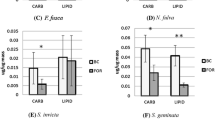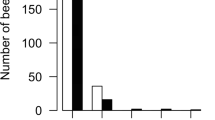Abstract
In some group-living organisms, labor is divided among individuals. This allocation to particular tasks is frequently stable and predicted by individual physiology. Social insects are excellent model organisms in which to investigate the interplay between physiology and individual behavior, as division of labor is an important feature within colonies, and individual physiology varies among the highly related individuals of the colony. Previous studies have investigated what factors are important in determining how likely an individual is, compared to nestmates, to perform certain tasks. One such task is foraging. Corpulence (i.e., percent lipid) has been shown to determine foraging propensity in honey bees and ants, with leaner individuals being more likely to be foragers. Is this a general trend across all social insects? Here we report data analyzing the individual physiology, specifically the percent lipid, of worker bumble bees (Bombus impatiens) from whom we also analyze behavioral task data. Bumble bees are also unusual among the social bees in that workers may vary widely in size. Surprisingly we find that, unlike other social insects, percent lipid is not associated with task propensity. Rather, body size closely predicts individual relative lipid stores, with smaller worker bees being allometrically fatter than larger worker bees.



Similar content being viewed by others
References
Alford DV (1975) Bumblebees. Davis-Poynter, London
Altmann J (1974) Observational Study of Behavior: Sampling Methods. Behaviour 49:227–266
Ben-Shahar Y, Robichon A, Sokolowski MB, Robinson GE (2002) Influence of gene action across different time scales on behavior. Science 296(5568):741–744
Beshers SN, Fewell JH (2001) Models of division of labor in social insects. Annu Rev Entomol 46(1):413–440
Blanchard GB, Orledge GM, Reynolds SE, Franks NR (2000) Division of labour and seasonality in the ant Leptothorax albipennis: worker corpulence and its influence on behaviour. Anim Behav 59(4):723–738
Bligh EG, Dyer WJ (1959) A rapid method of total lipid extraction and purification. Can J Physiol Pharm 37(8):911–917
Børgesen LW (2000) Nutritional function of replete workers in the pharaoh’s ant, Monomorium pharaonis. Insect Soc 47(2):141–146
Burgett DM, Young RG (1974) Lipid storage by honey ant repletes. Ann Entomol Soc Am 67:743–744
Cameron SA (1989) Temporal patterns of division of labor among workers in the primitively eusocial bumble bee, Bombus griseocollis (Hymenoptera: Apidae)). Ethology 80:137–151
Couvillon MJ, Dornhaus A (2009) Location, location, location: larvae position inside the nest is correlated with adult body size in worker bumble bees (Bombus impatiens). P Roy Soc Lond B Bio 276:2411–2418
Couvillon MJ, Dornhaus A (2010) Small worker bumble bees (Bombus impatiens) are hardier against starvation than their larger sisters. Insect Soc 57:193–197
Couvillon MJ, Jandt J, Duong N, Dornhaus A (2010) Ontogeny of worker body size distribution in bumble bee (Bombus impatiens) colonies. Ecol Entomol 35:424–435
Dornhaus A, Powell S (2010) Foraging and defence strategies. In: Lach L, Parr CL, Abbott KL (eds) Ant ecology. Oxford University Press, Oxford, p 385
Folch J, Lees M, Sloane-Stanley G (1957) A simple method for the isolation and purification of total lipids from animal tissues. J Biol Chem 226:495–509
Gäde G, Auerswald L (1998) Flight metabolism in carpenter bees and primary structure of their hypertrehalosaemic peptide. Exp Biol Online 3(6):1–11
Goulson D (2003) Bumblebees—behaviour and ecology. Oxford University Press, Oxford
Goulson D, Peat J, Stout JC, Tucker J, Darvill B, Derwent LC, Hughes WOH (2002) Can alloethism in workers of the bumblebee, Bombus terrestris, be explained in terms of foraging efficiency? Anim Behav 64:123–130
Hahn DA (2006) Two closely related species of desert carpenter ant differ in individual-level allocation to fat storage. Physiol Biochem Zool 79:847–856
Heinrich B (1975) Energetics of pollination. Annu Rev Ecol Syst 6:139–170
Hölldobler B, Wilson EO (1990) The ants. Belknap Press, Cambridge, MA
Jandt J, Dornhaus A (2009) Spatial organization and division of labor in the bumble bee, Bombus impatiens. Anim Behav 77:641–651
Jandt J, Huang E, Dornhaus A (2009) Weak specialization of workers inside a bumble bee (Bombus impatiens) nest. Behav Ecol Sociobiol 63(12):1829–1836
Jeanne RL (1986) The organization of work in Polybia occidentalis: costs and benefits of specialization in a social wasp. Behav Ecol Sociobiol 19(5):333–341
Jeanne RL (1991) Polyethism. In: Ross KG, Matthews RW (eds) The social biology of wasps. Cornell University, Ithaca
Katayama E (1973) Observations on the brood development in Bombus ignitus (Hymenoptera, Apidae) II. Brood development and feeding habits. Kontyû 41:203–216
Krebs JR, Davies NB (1997) Behavioural ecology: an evolutionary approach. Blackwell Scientific Publications, Oxford
Kukuk PF, Ward SA, Jozwiak A (1998) Mutualistic benefits generate an unequal distribution of risky activities among unrelated group members. Naturwissenschaften 85(9):445–449
Lachaud JP, Passera L, Grimal A, Detrain C, Beugnon G (1992) Lipid storage by major workers and starvation reistance in the ant Pheidole pallidula (Hymenoptera, Formicidae). In: Billen J (ed) Biology and evolution of social insects. Leuven University Press, Leuven (Belgium), pp 153–160
Markiewicz D, O’Donnell S (2001) Social dominance, task performance and nutrition: implications for reproduction in eusocial wasps. J Comp Physiol A 187(5):327–333
Michener CD (1974) The social behaviour of the bees. Harvard University Press, Cambridge, Mass
O’Donnell S, Jeanne RL (1995a) Implications of senescence patterns for the evolution of age polyethism in eusocial insects. Behav Ecol 6:269–273
O’Donnell S, Jeanne RL (1995b) The roles of body size and dominance in division of labor among workers of the eusocial wasp Polybia occidentalis (Olivier) (Hymenoptera: Vespidae). J Kansas Entomol Soc 68(1):43–50
O’Donnell S, Jeanne RL (1995c) Worker lipid stores decrease with outside-nest task performance in wasps: implications for the evolution of age polyethism. Cell Mol Life Sci 51(7):749–752
O’Donnell S (1995) Division of labor in post-emergence colonies of the primitively eusocial wasp Polistes instabilis de Saussure (Hymenoptera: Vespidae). Insect Soc 42(1):17–29
O’Donnell S, Jeanne RL (1992) Lifelong patterns of forager behaviour in a tropical swarm-founding wasp: effects of specialization and activity level on longevity. Anim Behav 44(6):1021–1027
Ojeda-Avila T, Arthur Woods H, Raguso RA (2003) Effects of dietary variation on growth, composition, and maturation of Manduca sexta (Sphingidae: Lepidoptera). J Insect Physiol 49(4):293–306
Pendrel BA, Plowright RC (1981) Larval feeding by adult bumble bee workers (Hymenoptera, Apidae). Behav Ecol Sociobiol 8(2):71–76
Pereboom JJM (1997) “…while they banquet splendidly the future mother…”. Utrecht University
Pereboom JJM, Velthuis HHW, Duchateau MJ (2003) The organisation of larval feeding in bumblebees (Hymenoptera, Apidae) and its significance to caste differentiation. Insect Soc 50(2):127–133
Plowright RC, Jay SC (1968) Caste differentiation in bumblebees (Bombus latr - Hym) 1. Determination of female size. Insect Soc 15(2):171–192
Porter SD, Jorgensen CD (1981) Foragers of the harvester ant, Pogonomyrmex owyheei: a disposable caste? Behav Ecol Sociobiol 9(4):247–256
Porter SD, Tschinkel WR (1985) Fire ant polymorphism: the ergonomics of brood production. Behav Ecol Sociobiol 16:323–336
Powell S, Tschinkel WR (1999) Ritualized conflict in Odontomachus brunneus and the generation of interaction-based task allocation: a new organizational mechanism in ants. Anim Behav 58:965–972
Pugesek BH (1995) Offspring growth in the California gull: reproductive effort and parental experience hypotheses. Anim Behav 49:641–647
Raguso RA, Ojeda-Avila T, Desai S, Jurkiewicz MA, Arthur Woods H (2007) The influence of larval diet on adult feeding behaviour in the tobacco hornworm moth, Manduca sexta. J Insect Physiol 53(9):923–932
Raubenheimer D, Simpson SJ (1996) Meeting nutrient requirements: the roles of power and efficiency. Entomol Exp Appl 80(1):65–68
Raubenheimer D, Simpson SJ (1997) Integrative models of nutrient balancing: application to insects and vertebrates. Nutr Res Rev 10:151–179
Raubenheimer D, Simpson SJ (1999) Integrating nutrition: a geometrical approach. Entomol Exp Appl 91(1):67–82
Ribeiro MF, Velthuis HHW, Duchateau MJ, van der Tweel I (1999) Feeding frequency and caste differentiation in Bombus terrestris larvae. Insect Soc 46:306–314
Robinson GE (1987) Regulation of honey bee age polyethism by juvenile hormone. Behav Ecol Sociobiol 20(5):329–338
Robinson GE (1992) Regulation of division-of-labor in insect societies. Annu Rev Entomol 37:637–665
Robinson E, Richardson T, Sendova-Franks A, Feinerman O, Franks N (2009a) Radio tagging reveals the roles of corpulence, experience and social information in ant decision making. Behav Ecol Sociobiol 63(5):627–636
Robinson EJH, Feinerman O, Franks NR (2009b) Flexible task allocation and the organization of work in ants. P Roy Soc Lond B Bio 276(1677):4373–4380
Rothe U, Nachtigall W (1989) Flight of the honey bee. J Comp Physiol A 158(6):739–749
Shingleton AW, Frankino WA, Flatt T, Nijhout HF, Emlen DJ (2007) Size and shape: the developmental regulation of static allometry in insects. Bioessays 29(6):536–548
Suhonen J (1993) Predation risk influences the use of foraging sites by tits. Ecology 74(4):1197–1203
Sutcliffe GH, Plowright RC (1988) The effects of food supply on adult size in the bumble bee Bombus terricola Kirby (Hymenoptera, Apidae). Can Entomol 120(12):1051–1058
Sutcliffe GH, Plowright RC (1990) The effects of pollen availability on development time in the bumble bee Bombus terricola K (Hymenoptera, Apidae). Can J Zool 68(6):1120–1123
Tofilski A (2002) Influence of age polyethism on longevity of workers in social insects. Behav Ecol Sociobiol 51:234–237
Toth AL, Robinson GE (2005) Worker nutrition and division of labour in honeybees. Anim Behav 69(2):427–435
Toth AL, Kantarovich S, Meisel AF, Robinson GE (2005) Nutritional status influences socially regulated foraging ontogeny in honey bees. J Exp Biol 208(24):4641–4649
Tschinkel W (1987) Seasonal life history and nest architecture of a winter-active ant, Prenolepis imparis. Insect Soc 34(3):143–164
Tschinkel WR (1993) Sociometry and sociogenesis of colonies of the fire ant Solenopsis invicta during one annual cycle. Ecol Monogr 63:425–457
Tschinkel WR (1998) Sociometry and sociogenesis of colonies of the harvester ant, Pogonomyrmex badius: worker characteristics in relation to colony size and season. Insect Soc 45(4):385–410
Visscher PK, Dukas R (1997) Suvivorship of foraging honey bees. Insect Soc 44:1–5
Warton DI, Wright IJ, Falster DS, Westoby M (2006) Bivariate line-fitting methods for allometry. Biol Rev 81:259–291
Wilson EO (1974) The soldier of the ant Camponotus (Colobopsis) fraxinicola as a trophic caste. Psyche 81:182–188
Wilson EO (1980) Caste and division of labor in leaf-cutter ants (Hymenoptera: Formicidae: Atta) I. The overall pattern in A.sexdens. Behav Ecol Sociobiol 7:143–156
Woyciechowski M, Kozlowski J (1998) Division of labor by division of risk according to worker life expectancy in the honey bee (Apis mellifera L.). Apidologie 29:191–205
Yerushalmi S, Bodenhaimer S, Bloch G (2006) Developmentally determined attenuation in circadian rhythms links chronobiology to social organization in bees. J Exp Biol 209(6):1044–1051
Acknowledgments
We would like to thank both Leif Abrell and Goggy Davidowitz for their help with our lipid extraction methodology. Additionally, Goggy allowed us to use his lab space for the work. Thanks to LASI Data Club for helpful discussions. MJC was funded by an NIH PERT Postdoctoral Fellowship through the Center for Insect Science at the University of Arizona.
Author information
Authors and Affiliations
Corresponding author
Rights and permissions
About this article
Cite this article
Couvillon, M.J., Jandt, J.M., Bonds, J. et al. Percent lipid is associated with body size but not task in the bumble bee Bombus impatiens . J Comp Physiol A 197, 1097–1104 (2011). https://doi.org/10.1007/s00359-011-0670-5
Received:
Revised:
Accepted:
Published:
Issue Date:
DOI: https://doi.org/10.1007/s00359-011-0670-5




